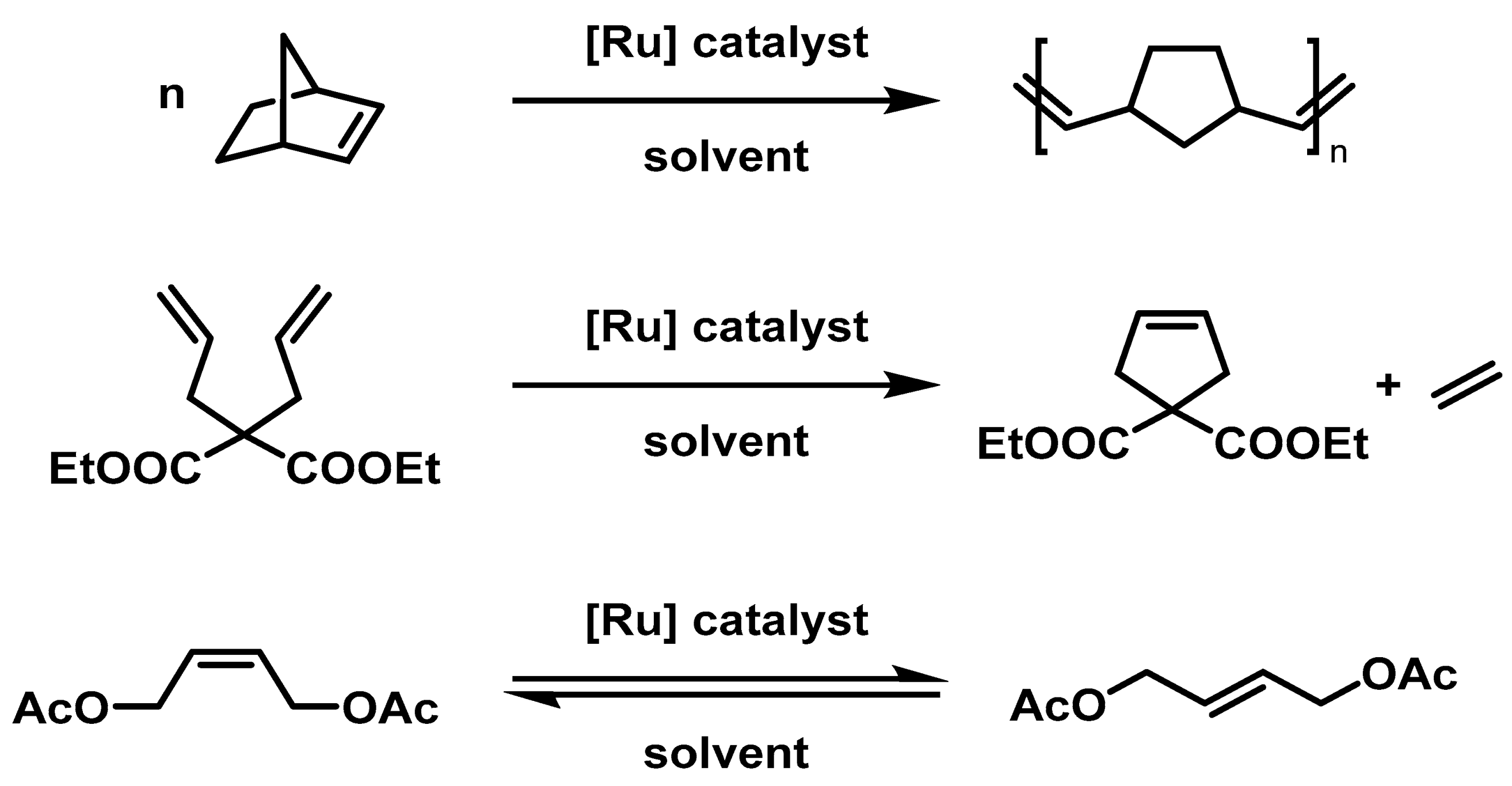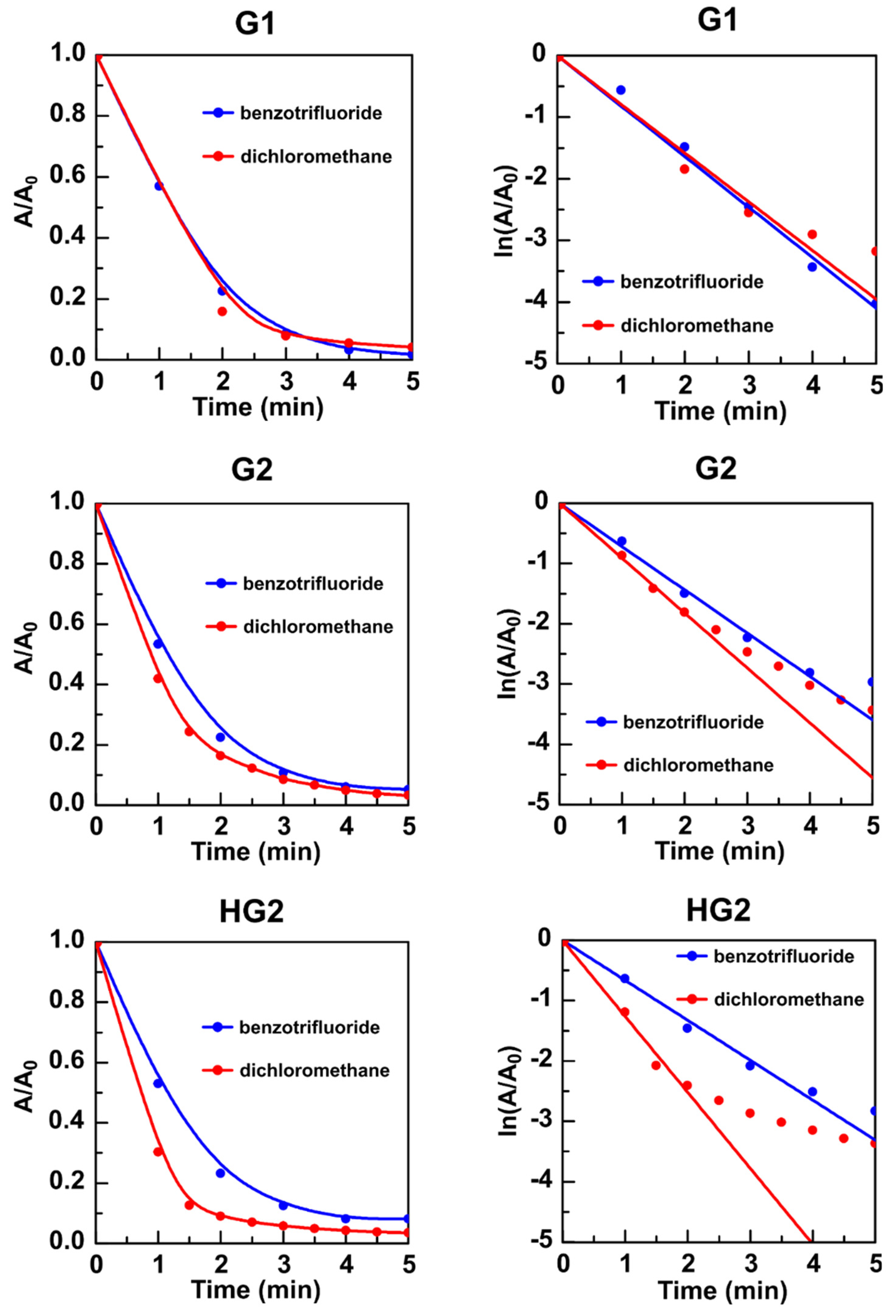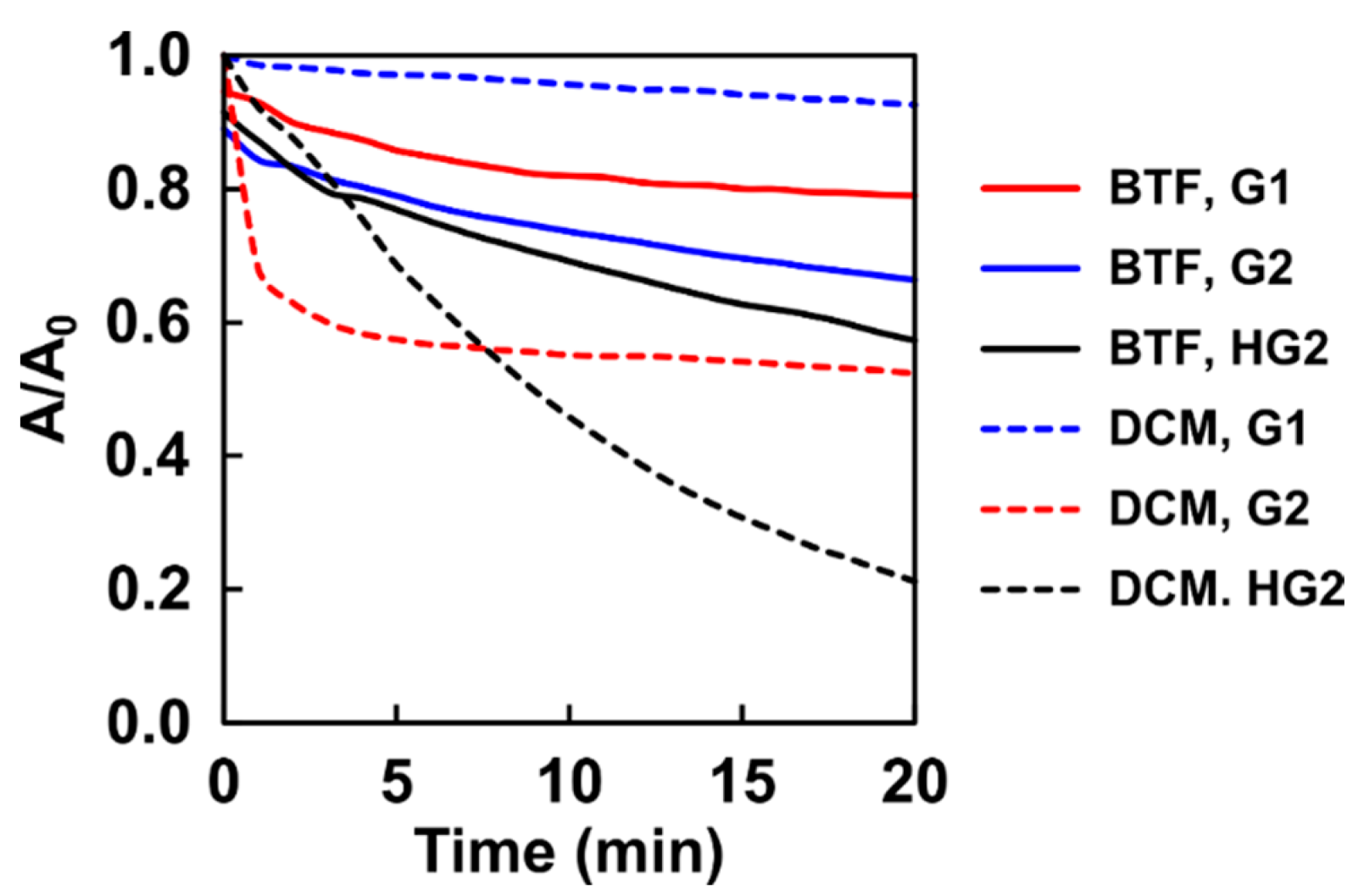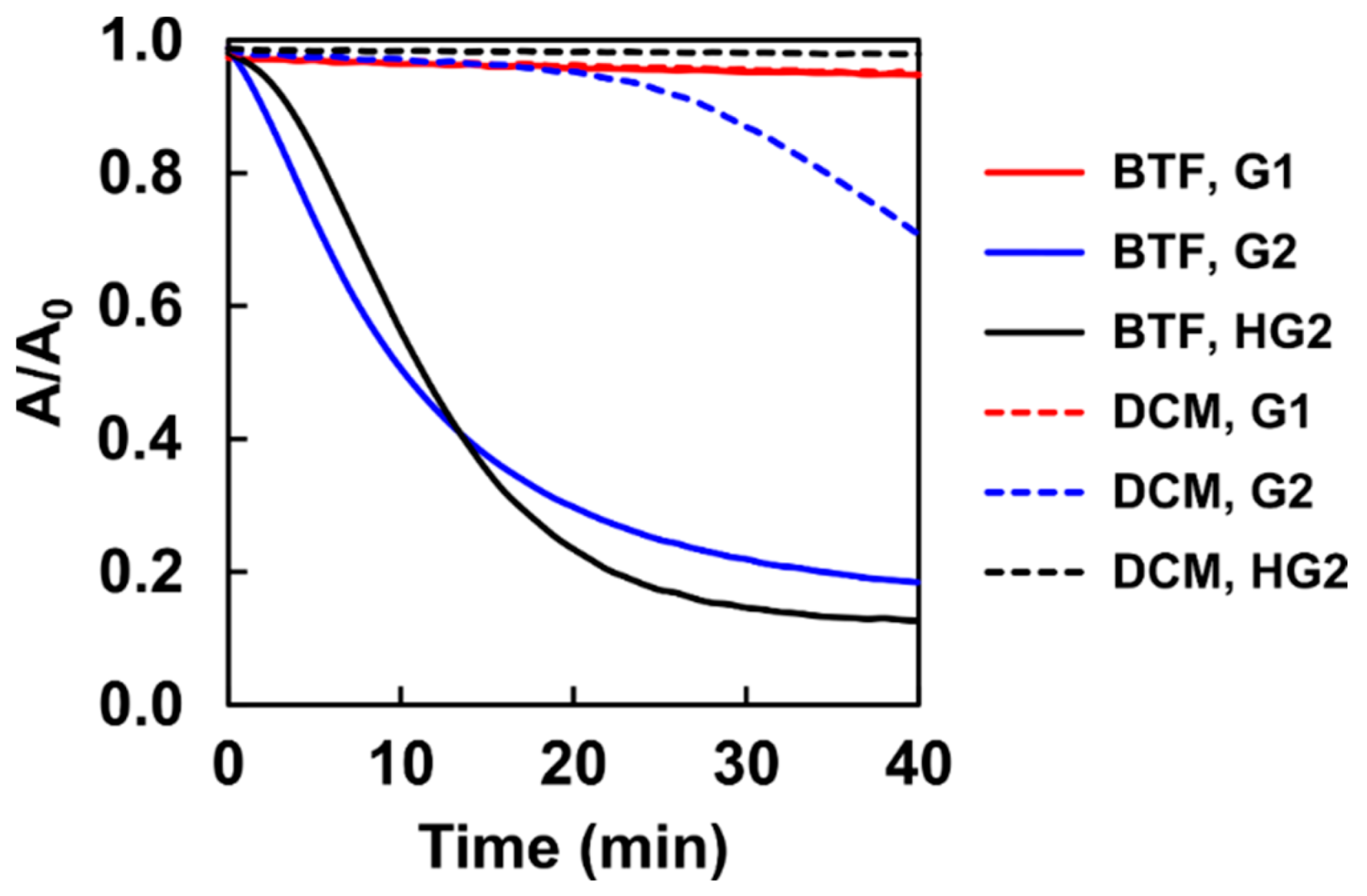Ring-Opening Metathesis Polymerization and Related Olefin Metathesis Reactions in Benzotrifluoride as an Environmentally Advantageous Medium †
Abstract
1. Introduction
2. Results and Discussion
2.1. Ring-Opening Metathesis Polymerization of Norbornene in Benzotrifluoride
2.2. Ring-Closing Metathesis
2.3. Isomerization Reaction
3. Materials and Methods
3.1. Materials
3.2. Kinetic Investigations
3.3. Synthesis of Polynorbornene for Turnover Number Determination in BTF and DCM
3.4. Characterization Methods
4. Conclusions
Supplementary Materials
Author Contributions
Funding
Institutional Review Board Statement
Informed Consent Statement
Data Availability Statement
Acknowledgments
Conflicts of Interest
References
- Vougioukalakis, G.C.; Grubbs, R.H. Ruthenium-based heterocyclic carbene-coordinated olefin metathesis catalysts. Chem. Rev. 2010, 110, 1746–1787. [Google Scholar] [CrossRef] [PubMed]
- Hoveyda, A.H.; Zhugralin, A.R. The remarkable metal-catalysed olefin metathesis reaction. Nature 2007, 450, 243–251. [Google Scholar] [CrossRef] [PubMed]
- Samojłowicz, C.; Bieniek, M.; Grela, K. Ruthenium-based olefin metathesis catalysts bearing N-heterocyclic carbene ligands. Chem. Rev. 2009, 109, 3708–3742. [Google Scholar] [CrossRef] [PubMed]
- Herz, K.; Elser, I.; Buchmeiser, M.R. Ring-Opening Metathesis Polymerization: Mechanisms. In Macromolecular Engineering: From Precise Synthesis to Macroscopic Materials and Applications, 2nd ed.; Hadjichristidis, N., Gnanou, Y., Matyjaszewski, K., Muthukumar, M., Eds.; Wiley-VCH: Weinheim, Germany, 2022; Volume 5, pp. 1–50. [Google Scholar] [CrossRef]
- Buchmeiser, M.R. Homogeneous Metathesis Polymerization by Well-Defined Group VI and Group VIII Transition-Metal Alkylidenes: Fundamentals and Applications in the Preparation of Advanced Materials. Chem. Rev. 2000, 100, 1565–1604. [Google Scholar] [CrossRef] [PubMed]
- Benedikter, M.J.; Ziegler, F.; Groos, J.; Hauser, P.M.; Schowner, R.; Buchmeiser, M.R. Group 6 metal alkylidene and alkylidyne N-heterocyclic carbene complexes for olefin and alkyne metathesis. Coord. Chem. Rev. 2020, 415, 213315. [Google Scholar] [CrossRef]
- Song, S.; Chang, Y.; Oh, S.H.; Kim, S.; Choi, S.; Kim, S.; Lee, J.-K.; Choi, S.-H.; Lim, J. Fluorous Dispersion Ring-Opening Metathesis Polymerization. Macromolecules 2022, 55, 1515–1523. [Google Scholar] [CrossRef]
- Cater, H.L.; Balynska, I.; Allen, M.J.; Freeman, B.D.; Page, Z.A. User Guide to Ring-Opening Metathesis Polymerization of endo-Norbornene Monomers with Chelated Initiators. Macromolecules 2022, 55, 6671–6679. [Google Scholar] [CrossRef]
- Zhang, Z.; Yang, Z.; Zhou, F.; He, X. Effect of different catalyst ratios on the ring-opening metathesis polymerization (ROMP) of dicyclopentadiene. Polyolefins J. 2022, 9, 151–162. [Google Scholar] [CrossRef]
- Sample, C.S.; Kellstedt, E.A.; Hillmyer, M.A. Tandem ROMP/Hydrogenation Approach to Hydroxy-Telechelic Linear Polyethylene. ACS Macro Lett. 2022, 11, 608–614. [Google Scholar] [CrossRef]
- Yasir, M.; Singh, M.; Kilbinger, A.F.M. A Single Functionalization Agent for Heterotelechelic ROMP Polymers. ACS Macro Lett. 2022, 11, 813–817. [Google Scholar] [CrossRef]
- Mandal, A.; Mandal, I.; Kilbinger, A.F.M. Pulsed-Addition ROMP: Catalytic Syntheses of Heterotelechelic Polymers via Regioselective Chain Transfer Agents. ACS Macro Lett. 2022, 11, 491–497. [Google Scholar] [CrossRef]
- Dong, Z.; Liu, P.; Crochet, A.; Kilbinger, A.F.M. Fast Ring-Opening Metathesis Polymerization of Tricyclic Oxanorbornene Derivatives. Macromolecules 2022, 55, 3681–3687. [Google Scholar] [CrossRef]
- Rajkiewicz, A.A.; Kajetanowicz, A.; Grela, K. Self-Supported Polymeric Ruthenium Complexes as Olefin Metathesis Catalysts in Synthesis of Heterocyclic Compounds. Catalysts 2022, 12, 1087. [Google Scholar] [CrossRef]
- Liu, Z.; Gu, G.; Chen, J.; Duan, Z.; Liu, B. Construction of Bio-Based Polyurethanes via Olefin Metathesis and Their Thermal Reversible Behavior. Polymers 2022, 14, 3597. [Google Scholar] [CrossRef]
- Nadirova, M.; Zieliński, A.; Malinska, M.; Kajetanowicz, A. Fast Initiating Furan-Containing Hoveyda-Type Complexes: Synthesis and Applications in Metathesis Reactions. Chemistry 2022, 4, 786–795. [Google Scholar] [CrossRef]
- Roenko, A.V.; Nikiforov, R.Y.; Gringolts, M.L.; Belov, N.A.; Denisova, Y.I.; Shandryuk, G.A.; Bondarenko, G.N.; Kudryavtsev, Y.V.; Finkelshtein, E.S. Olefin-Metathesis-Derived Norbornene-Ethylene-Vinyl Acetate/Vinyl Alcohol Multiblock Copolymers: Impact of the Copolymer Structure on the Gas Permeation Properties. Polymers 2022, 14, 444. [Google Scholar] [CrossRef]
- Mol, J.C. Industrial applications of olefin metathesis. J. Mol. Catal. A Chem. 2004, 213, 39–45. [Google Scholar] [CrossRef]
- Busacca, C.A.; Fandrick, D.R.; Song, J.J.; Senanayake, C.H. The growing impact of catalysis in the pharmaceutical industry. Adv. Synth. Catal. 2011, 353, 1825–1864. [Google Scholar] [CrossRef]
- Magano, J.; Dunetz, J.R. Large-scale applications of transition metal-catalyzed couplings for the synthesis of pharmaceuticals. Chem. Rev. 2011, 111, 2177–2250. [Google Scholar] [CrossRef]
- Mandal, A.; Mandal, I.; Kilbinger, A.F.M. Catalytic Syntheses of Degradable Polymers via Ring-Opening Metathesis Copolymerization Using Vinyl Ethers as Chain Transfer Agents. Macromolecules 2022, 55, 7827–7833. [Google Scholar] [CrossRef]
- Adjiman, C.S.; Clarke, A.J.; Cooper, G.; Taylor, P.C. Solvents for ring-closing metathesis reactions. Chem. Commun. 2008, 2806–2808. [Google Scholar] [CrossRef] [PubMed]
- Patra, S.G.; Das, N.K. Recent advancement on the mechanism of olefin metathesis by Grubbs catalysts: A computational perspective. Polyhedron 2021, 200, 115096. [Google Scholar] [CrossRef]
- Mathers, R.T.; McMahon, K.C.; Damodaran, K.; Retarides, C.J.; Kelley, D.J. Ring-Opening Metathesis Polymerizations in d-Limonene: A Renewable Polymerization Solvent and Chain Transfer Agent for the Synthesis of Alkene Macromonomers. Macromolecules 2006, 39, 8982–8986. [Google Scholar] [CrossRef]
- Song, J.; Hou, M.; Liu, G.; Zhang, J.; Han, B.; Yang, G. Effect of Phase Behavior on the Ethenolysis of Ethyl Oleate in Compressed CO2. J. Phys. Chem. B 2009, 113, 2810–2814. [Google Scholar] [CrossRef]
- Fürstner, A.; Koch, D.; Langemann, K.; Leitner, W.; Six, C. Olefin Metathesis in Compressed Carbon Dioxide. Angew. Chemie Int. Ed. 1997, 36, 2466–2469. [Google Scholar] [CrossRef]
- Michalek, F.; Mädge, D.; Rühe, J.; Bannwarth, W. Ring-Closure Metathesis in Supercritical Carbon Dioxide as Sole Solvent with Use of Covalently Immobilized Ruthenium Catalysts. Eur. J. Org. Chem. 2006, 2006, 577–581. [Google Scholar] [CrossRef]
- Fürstner, A.; Ackermann, L.; Beck, K.; Hori, H.; Koch, D.; Langemann, K.; Liebl, M.; Six, C.; Leitner, W. Olefin Metathesis in Supercritical Carbon Dioxide. J. Am. Chem. Soc. 2001, 123, 9000–9006. [Google Scholar] [CrossRef]
- Hu, X.; Blanda, M.T.; Venumbaka, S.R.; Cassidy, P.E. Ring-opening metathesis polymerization (ROMP) of norbornene in supercritical carbon dioxide using well-defined metal carbene catalysts. Polym. Adv. Technol. 2005, 16, 146–149. [Google Scholar] [CrossRef]
- Hamilton, J.G.; Rooney, J.J.; DeSimone, J.M.; Mistele, C. Stereochemistry of Ring-Opened Metathesis Polymers Prepared in Liquid CO2 at High Pressure Using Ru(H2O)6(Tos)2 as Catalyst. Macromolecules 1998, 31, 4387–4389. [Google Scholar] [CrossRef]
- Mistele, C.D.; Thorp, H.H.; Desimone, J.M. Ring-Opening Metathesis Polymerizations in Carbon Dioxide. J. Macromol. Sci. Part A 1996, 33, 953–960. [Google Scholar] [CrossRef]
- Smoleń, M.; Marczyk, A.; Kośnik, W.; Trzaskowski, B.; Kajetanowicz, A.; Grela, K. Ruthenium-Catalysed Olefin Metathesis in Environmentally Friendly Solvents: 2-Methyltetrahydrofuran Revisited. European, J. Org. Chem. 2019, 2019, 640–646. [Google Scholar] [CrossRef]
- Smoleń, M.; Kośnik, W.; Gajda, R.; Woźniak, K.; Skoczeń, A.; Kajetanowicz, A.; Grela, K. Ruthenium Complexes Bearing Thiophene-Based Unsymmetrical N-Heterocyclic Carbene Ligands as Selective Catalysts for Olefin Metathesis in Toluene and Environmentally Friendly 2-Methyltetrahydrofuran. Chem.—A Eur. J. 2018, 24, 15372–15379. [Google Scholar] [CrossRef]
- Ashworth, I.W.; Nelson, D.J.; Percy, J.M. Solvent effects on Grubbs’ pre-catalyst initiation rates. Dalt. Trans. 2013, 42, 4110–4113. [Google Scholar] [CrossRef]
- Rajkiewicz, A.A.; Skowerski, K.; Trzaskowski, B.; Kajetanowicz, A.; Grela, K. 2-Methyltetrahydrofuran as a Solvent of Choice for Spontaneous Metathesis/Isomerization Sequence. ACS Omega 2019, 4, 1831–1837. [Google Scholar] [CrossRef]
- Nienałtowski, T.; Krzesiński, P.; Baumert, M.E.; Skoczeń, A.; Suska-Kauf, E.; Pawłowska, J.; Kajetanowicz, A.; Grela, K. 4-Methyltetrahydropyran as a Convenient Alternative Solvent for Olefin Metathesis Reaction: Model Studies and Medicinal Chemistry Applications. ACS Sustain. Chem. Eng. 2020, 8, 18215–18223. [Google Scholar] [CrossRef]
- Blosch, S.E.; Alaboalirat, M.; Eades, C.B.; Scannelli, S.J.; Matson, J.B. Solvent Effects in Grafting-through Ring-Opening Metathesis Polymerization. Macromolecules 2022, 55, 3522–3532. [Google Scholar] [CrossRef]
- Dumas, A.; Colombel-Rouen, S.; Curbet, I.; Forcher, G.; Tripoteau, F.; Caijo, F.; Queval, P.; Rouen, M.; Baslé, O.; Mauduit, M. Highly selective macrocyclic ring-closing metathesis of terminal olefins in non-chlorinated solvents at low dilution. Catal. Sci. Technol. 2019, 9, 436–443. [Google Scholar] [CrossRef]
- Bakhrou, N.; Lamaty, F.; Martinez, J.; Colacino, E. Ring-closing metathesis in glycerol under microwave activation. Tetrahedron Lett. 2010, 51, 3935–3937. [Google Scholar] [CrossRef]
- Bruneau, C.; Fischmeister, C. Olefin Metathesis in Green Organic Solvents and without Solvent. In Olefin Metathesis: Theory and Practice; Grela, K., Ed.; John Wiley & Sons, Inc.: Hoboken, NJ, USA, 2014; pp. 523–535. [Google Scholar] [CrossRef]
- Bantreil, X.; Sidi-Ykhlef, M.; Aringhieri, L.; Colacino, E.; Martinez, J.; Lamaty, F. Comprehensive study on olefin metathesis in PEG as an alternative solvent under microwave irradiation. J. Catal. 2012, 294, 113–118. [Google Scholar] [CrossRef]
- Planer, S.; Jana, A.; Grela, K. Ethyl Lactate: A Green Solvent for Olefin Metathesis. ChemSusChem 2019, 12, 4655–4661. [Google Scholar] [CrossRef]
- Skowerski, K.; Białecki, J.; Tracz, A.; Olszewski, T.K. An attempt to provide an environmentally friendly solven selection guide for olefin metathesis. Green Chem. 2014, 16, 1125–1130. [Google Scholar] [CrossRef]
- Miao, X.; Fischmeister, C.; Bruneau, C.; Dixneuf, P.H. Dimethyl Carbonate: An Eco-Friendly Solvent in Ruthenium-Catalyzed Olefin Metathesis Transformations. ChemSusChem 2008, 1, 813–816. [Google Scholar] [CrossRef] [PubMed]
- Bilel, H.; Hamdi, N.; Zagrouba, F.; Fischmeister, C.; Bruneau, C. Cross-metathesis transformations of terpenoids in dialkyl carbonate solvents. Green Chem. 2011, 13, 1448–1452. [Google Scholar] [CrossRef]
- Maul, J.J.; Ostrowski, P.J.; Ublacker, G.A.; Linclau, B.; Curran, D.P. Benzotrifluoride and Derivatives: Useful Solvents for Organic Synthesis and Fluorous Synthesis. In Modern Solvents in Organic Synthesis. Topics in Current Chemistry; Knochel, P., Ed.; Springer: Berlin/Heidelberg, Germany, 1999; Volume 206, pp. 79–105. [Google Scholar] [CrossRef]
- Ogawa, A.; Tsuchii, K. α,α,α-Trifluorotoluene. Encycl. Reagents Org. Synth. 2005. [Google Scholar] [CrossRef]
- Ogawa, A.; Curran, D.P. Benzotrifluoride: A Useful Alternative Solvent for Organic Reactions Currently Conducted in Dichloromethane and Related Solvents. J. Org. Chem. 1997, 62, 450–451. [Google Scholar] [CrossRef]
- Tamai, T.; Nomoto, A.; Tsuchii, K.; Minamida, Y.; Mitamura, T.; Sonoda, M.; Ogawa, A. Highly selective perfluoroalkylchalcogenation of alkynes by the combination of iodoperfluoroalkanes and organic dichalcogenides upon photoirradiation. Tetrahedron 2012, 68, 10516–10522. [Google Scholar] [CrossRef]
- Ye, X.; Dai, X.; Meng, S.; Fu, X.; Chen, S. A Novel CdS/g-C3N4 Composite Photocatalyst: Preparation, Characterization and Photocatalytic Performance with Different Reaction Solvents under Visible Light Irradiation. Chin. J. Chem. 2017, 35, 217–225. [Google Scholar] [CrossRef]
- Foster, D.; Gao, P.; Zhang, Z.; Sipos, G.; Sobolev, A.N.; Nealon, G.; Falivene, L.; Cavallo, L.; Dorta, R. Design, scope and mechanism of highly active and selective chiral NHC–iridium catalysts for the intramolecular hydroamination of a variety of unactivated aminoalkenes. Chem. Sci. 2021, 12, 3751–3767. [Google Scholar] [CrossRef]
- Shimomoto, H.; Fukami, D.; Kanaoka, S.; Aoshima, S. Fluorine-containing vinyl ether polymers: Living cationic polymerization in fluorinated solvents as new media and unique solubility characteristics in organic solvents. J. Polym. Sci. Part A Polym. Chem. 2011, 49, 1174–1182. [Google Scholar] [CrossRef]
- Hussain, H.; Tan, B.H.; Mya, K.Y.; Liu, Y.; He, C.B.; Davis, T.P. Synthesis, micelle formation and bulk properties of poly(ethylene glycol)b-poly(pentafluorostyrene)-g-polyhedral oligomeric silsesquioxane amphiphilic hybrid copolymers. J. Polym. Sci. Part A Polym. Chem. 2010, 48, 152–163. [Google Scholar] [CrossRef]
- Kukhta, N.A.; Vasilenko, I.V.; Kostjuk, S.V. Room temperature cationic polymerization of β-pinene using modified AlCl3 catalyst: Toward sustainable plastics from renewable biomass resources. Green Chem. 2011, 13, 2362–2364. [Google Scholar] [CrossRef]
- Kostjuk, S.V.; Ouardad, S.; Peruch, F.; Deffieux, A.; Absalon, C.; Puskas, J.E.; Ganachaud, F. Carbocationic polymerization of isoprene Co-initiated by B(C6F5)3: An alternative route toward natural rubber polymer analogues? Macromolecules 2011, 44, 1372–1384. [Google Scholar] [CrossRef]
- Verebélyi, K.; Iván, B. Cationic polymerization of styrene by the TiCl4/N,N,N′,N′-tetramethylethylenediamine (TMEDA) catalyst system in benzotrifluoride, an environmentally benign solvent, at room temperature. Polymer 2012, 53, 3426–3431. [Google Scholar] [CrossRef]
- Verebélyi, K.; Szabó, Á.; Iván, B. Quasiliving atom transfer radical polymerization of styrene and n-butyl acrylate as non-fluorous monomers in a fluorinated solvent, benzotrifluoride. Polymer 2012, 53, 4940–4946. [Google Scholar] [CrossRef]
- Vasilenko, I.V.; Shiman, D.I.; Kostjuk, S. V Highly reactive polyisobutylenes via AlCl3OBu2-coinitiated cationic polymerization of isobutylene: Effect of solvent polarity, temperature, and initiator. J. Polym. Sci. Part A Polym. Chem. 2012, 50, 750–758. [Google Scholar] [CrossRef]
- Pásztói, B.; Trötschler, T.M.; Szabó, Á.; Kerscher, B.; Tenhu, H.; Mülhaupt, R.; Iván, B. Quasiliving cationic ring-opening polymerization of 2-ethyl-2-oxazoline in benzotrifluoride, as an alternative reaction medium. Polymer 2021, 212, 123165. [Google Scholar] [CrossRef]
- Walsh, D.J.; Lau, S.H.; Hyatt, M.G.; Guironnet, D. Kinetic Study of Living Ring-Opening Metathesis Polymerization with Third-Generation Grubbs Catalysts. J. Am. Chem. Soc. 2017, 139, 13644–13647. [Google Scholar] [CrossRef]
- Love, J.A.; Sanford, M.S.; Day, M.W.; Grubbs, R.H. Synthesis, Structure, and Activity of Enhanced Initiators for Olefin Metathesis. J. Am. Chem. Soc. 2003, 125, 10103–10109. [Google Scholar] [CrossRef][Green Version]
- Ton, S.J.; Fogg, D.E. The Impact of Oxygen on Leading and Emerging Ru-Carbene Catalysts for Olefin Metathesis: An Unanticipated Correlation Between Robustness and Metathesis Activity. ACS Catal. 2019, 9, 11329–11334. [Google Scholar] [CrossRef]
- Guidone, S.; Songis, O.; Nahra, F.; Cazin, C.S.J. Conducting Olefin Metathesis Reactions in Air: Breaking the Paradigm. ACS Catal. 2015, 5, 2697–2701. [Google Scholar] [CrossRef]
- Piola, L.; Nahra, F.; Nolan, S.P. Olefin metathesis in air. Beilstein J. Org. Chem. 2015, 11, 2038–2056. [Google Scholar] [CrossRef] [PubMed]
- Luján, C.; Nolan, S.P. E/Z selectivity in ruthenium-mediated cross metathesis. Catal. Sci. Technol. 2012, 2, 1027–1032. [Google Scholar] [CrossRef]
- Kovács, E.; Turczel, G.; Varga, R.; Tóth, I.; Szabo, L.; Anastas, P.T.; Tuba, R. Synthesis of 1,6-Hexandiol, Polyurethane Monomer Derivatives via Isomerization Metathesis of Methyl Linolenate. ACS Sustain. Chem. Eng. 2017, 5, 11215–11220. [Google Scholar] [CrossRef]
- Katz, T.J.; Lee, S.J.; Acton, N. Stereospecific polymerizations of cycloalkenes induced by a metal-carbene. Tetrahedron Lett. 1976, 17, 4247–4250. [Google Scholar] [CrossRef]





| Solvent | Catalyst (mol%) | k1 (min−1) | t1/2 (min) | Mn·10−3 (g/mol) * |
|---|---|---|---|---|
| BTF | G1 (0.050) | 0.82 | 0.85 | 138.7 |
| DCM | G1 (0.050) | 0.79 | 0.88 | 157.0 |
| BTF | G2 (0.010) | 0.72 | 0.96 | 106.0 |
| DCM | G2 (0.010) | 0.91 | 0.76 | 245.1 |
| BTF | HG2 (0.003) | 0.66 | 1.05 | 175.8 |
| DCM | HG2 (0.003) | 1.26 | 0.55 | 363.5 |
| Solvent | Catalyst | Conversion * | Turnover Number * |
|---|---|---|---|
| BTF | G1 | 0.77 | 385,100 |
| DCM | G1 | 0.95 | 477,100 |
| BTF | G2 | >0.99 | 499,900 |
| DCM | G2 | >0.99 | 499,500 |
| BTF | HG2 | 0.96 | 481,200 |
| DCM | HG2 | >0.99 | 499,800 |
| Solvent | Catalyst | k1 (min−1) | Conversion at 20 min (%) | Conversion at 24 h (%) |
|---|---|---|---|---|
| BTF | G1 | 0.019 | 21 | 55 |
| DCM | G1 | 0.202 | 47 | >99 |
| BTF | G2 | 0.024 | 34 | 96 |
| DCM | G2 | 0.005 | 7 | >99 |
| BTF | HG2 | 0.033 | 43 | 80 |
| DCM | HG2 | 0.075 | 78 | >99 |
| Solvent | Catalyst | k1 (min−1) | Conversion at 20 min (%) | Conversion at 72 h (%) |
|---|---|---|---|---|
| BTF | G1 | <0.001 | 4 | 19 |
| DCM | G1 | <0.001 | 4 | 20 |
| BTF | G2 | 0.070 | 70 | 89 |
| DCM | G2 | 0.021 | 5 | 93 |
| BTF | HG2 | 0.092 | 77 | 88 |
| DCM | HG2 | 0.009 | 2 | 93 |
Disclaimer/Publisher’s Note: The statements, opinions and data contained in all publications are solely those of the individual author(s) and contributor(s) and not of MDPI and/or the editor(s). MDPI and/or the editor(s) disclaim responsibility for any injury to people or property resulting from any ideas, methods, instructions or products referred to in the content. |
© 2022 by the authors. Licensee MDPI, Basel, Switzerland. This article is an open access article distributed under the terms and conditions of the Creative Commons Attribution (CC BY) license (https://creativecommons.org/licenses/by/4.0/).
Share and Cite
Kovács, E.; Balterer, B.; Anh Duc, N.; Szarka, G.; Owen, M.C.; Domján, A.; Iván, B. Ring-Opening Metathesis Polymerization and Related Olefin Metathesis Reactions in Benzotrifluoride as an Environmentally Advantageous Medium. Int. J. Mol. Sci. 2023, 24, 671. https://doi.org/10.3390/ijms24010671
Kovács E, Balterer B, Anh Duc N, Szarka G, Owen MC, Domján A, Iván B. Ring-Opening Metathesis Polymerization and Related Olefin Metathesis Reactions in Benzotrifluoride as an Environmentally Advantageous Medium. International Journal of Molecular Sciences. 2023; 24(1):671. https://doi.org/10.3390/ijms24010671
Chicago/Turabian StyleKovács, Ervin, Bence Balterer, Nguyen Anh Duc, Györgyi Szarka, Michael C. Owen, Attila Domján, and Béla Iván. 2023. "Ring-Opening Metathesis Polymerization and Related Olefin Metathesis Reactions in Benzotrifluoride as an Environmentally Advantageous Medium" International Journal of Molecular Sciences 24, no. 1: 671. https://doi.org/10.3390/ijms24010671
APA StyleKovács, E., Balterer, B., Anh Duc, N., Szarka, G., Owen, M. C., Domján, A., & Iván, B. (2023). Ring-Opening Metathesis Polymerization and Related Olefin Metathesis Reactions in Benzotrifluoride as an Environmentally Advantageous Medium. International Journal of Molecular Sciences, 24(1), 671. https://doi.org/10.3390/ijms24010671








